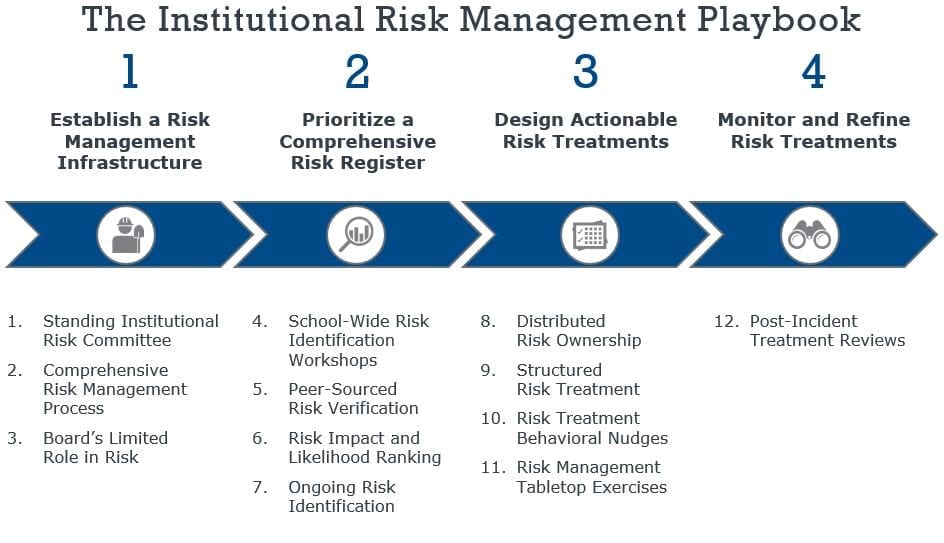As our world grows more complex, independent schools must confront new threats to their school communities. In order to prepare for and address a broad array of institutional risks—including those that are more likely to have an impact on independent schools—schools must establish a comprehensive risk management process.
Such a process includes identifying the right people and process for risk management, finding and prioritizing potential risks across the institution, creating thorough, actionable plans to treat risks, and monitoring the effectiveness of these plans on an ongoing basis.
EAB researchers shared best practice strategies for institutional risk management (IRM) at the 2019 Independent School Executive Forum’s executive roundtable series. To help schools establish an effective institutional risk management process, we have identified 12 practices across four areas, listed below (click to expand).

The resources below are designed to help schools deploy the above strategies and have an immediate impact on managing institutional risk.
Resource 1: Institutional Risk Management Maturity Assessment
In the course of our research we learned that that most independent schools don’t engage in a formal, comprehensive risk management process. Instead, they implement certain elements of risk management, often limited to preparing for major crises, which leaves them vulnerable to the many other types of risk that more commonly impact independent schools.
Use this assessment to understand the maturity of your current institutional risk management process in relation to best practice to identify gaps and plan next steps.
Resource 2: The Institutional Risk Management Playbook Brief
Implementing an IRM process can be daunting. To help guide you through this intimidating process, we have clearly outlined how schools can systematically move from a crisis preparedness approach to establish a comprehensive risk management process.
Use this brief to guide the implementation of a comprehensive risk management process at your school.
Resource 3: IRM Leader’s Communication Companion Toolkit
The IRM process requires investment from all members of the school community. In order to ensure that everyone from senior leadership to board members to faculty and staff are bought in, this toolkit provides strategies and planning tools to effectively communicate work happening around institutional risk management.
Use this toolkit to develop an initial school-wide communication strategy, address potential roadblocks, and inform an ongoing messaging strategy.
Resource 4: Board Communications Slides
An effective board of trustees plays a limited (but critical) role when it comes to the IRM process. Communicate this role effectively to ensure an appropriate level of board buy-in and involvement.
Use these slides to educate your school’s board on the IRM process and clarify their role.
Resource 5: EAB Sample Risk Register
Many schools lack a clear, objective method to identify, prioritize, and plan how to treat risks. A risk register allows schools to organize all potential risks and risk treatments in one location by allowing you to assign risks to categories, track risk scores based on objective criteria, and monitor risk treatments.
Use this tool to build your school’s risk register.
Resource 6: List of Potential Risks to Independent Schools
Schools today face many potential risks, and ensuring that all relevant risks have been identified can be daunting. To help schools build out and verify the comprehensiveness of their own list of risks, we have compiled a list of potential risks from partner and non-partner schools.
Use this risk list to verify the comprehensiveness of your school’s risk register.
Resource 7: Risk Tolerance Discussion Guide
An important element of knowing how to appropriately treat a risk includes determining your school’s tolerance for a given risk—that is, how much remaining risk you can tolerate after a risk has been treated. As you begin to address institutional risks during the IRM process, you will need to determine a new goal risk score to guide the risk owner in creating a treatment.
Use this guide to discuss your school’s tolerance for a given risk and determine a goal risk score to share with risk owners.
Resource 8: Risk Treatment Template
While most independent schools create policies and protocols to prevent and respond to crises, there are many other risks that must also be addressed. After building and ranking a list of institutional risks, schools must create risk treatments for all prioritized risks.
Use this risk treatment template to walk risk owners through every aspect of comprehensively treating a risk, which includes thirteen separate components.
Resource 9: Partner School Examples
During our research, EAB identified several schools that have taken steps to effectively implement aspects of the IRM process.The Pingry School provides an example of how you can codify the IRM process, as well as an example of how to educate the school community about the process and encourage them to identify and report risks. In order to make sure that everyone is ready and able to execute appropriate responses to incidents, the St. Stephen’s and St. Agnes School’s administrative team uses tabletop exercises to prepare for a wide range of risks.